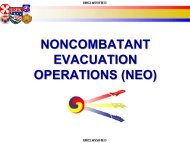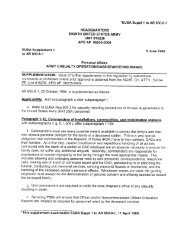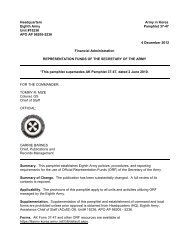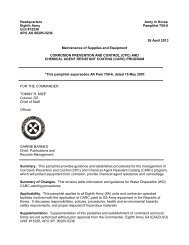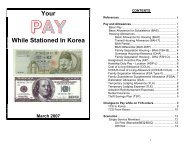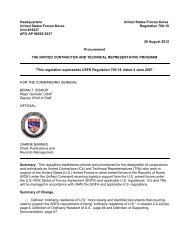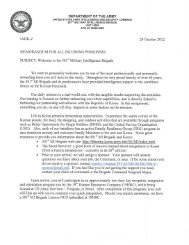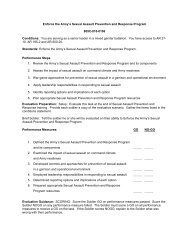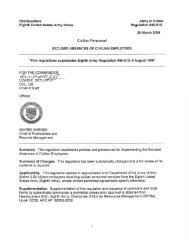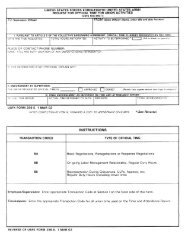AK Pamphlet 350-20 Eighth Army Range and Training Area
AK Pamphlet 350-20 Eighth Army Range and Training Area
AK Pamphlet 350-20 Eighth Army Range and Training Area
You also want an ePaper? Increase the reach of your titles
YUMPU automatically turns print PDFs into web optimized ePapers that Google loves.
(3) Notify the servicing <strong>Range</strong> Control Center of the fire.<br />
f. <strong>Range</strong> Control Center will require the following information:<br />
(1) Unit POC for information concerning the fire<br />
(2) Location of fire, grid coordinates<br />
(3) Cardinal direction <strong>and</strong> approximate speed the fire is moving<br />
(4) Wind direction <strong>and</strong> estimated speed<br />
(5) Approximate time fire started<br />
(6) Number of personnel fighting the fire<br />
(7) Type of firefighting equipment being used<br />
(8) Radio frequency being used<br />
(9) Any additional facts, i.e. number <strong>and</strong> size of any explosions, fire spreading<br />
over backstop or towards populated area, any firebreaks which can be used to help control the<br />
fire, etc.<br />
g. Organize continuous shifts to fight the fire until it is extinguished.<br />
h. Personnel will not be sent downrange until <strong>Range</strong> Control gives clearance.<br />
i. The unit will update <strong>Range</strong> Control hourly on the condition of the fire <strong>and</strong> immediately<br />
after a fire has been extinguished.<br />
4. GENERAL FIRE FIGHTING TECHNIQUES:<br />
a. Before containing the fire:<br />
(1) When arriving at the fire, first determine which direction the fire is moving (fire<br />
movement is not necessarily the direction of the wind).<br />
(2) Determine if there are any natural or man-made fire breaks in the path of the<br />
fire (e.g., roads, bodies of water, existing fire lines).<br />
(3) Crews should then begin to contain the fire by starting at the flanks <strong>and</strong><br />
working toward the lead, when possible, as shown in Figure 1.<br />
(4) Crews should be careful to avoid hazardous areas that burn very hot as<br />
shown in Figure 2.<br />
(5) The use of beaters, Figure 3, is the most effective method of containing fires.<br />
When the fire becomes so hot that personnel cannot work close enough to beat the flames,<br />
crews can contain the fire by cutting a fire line using shovels <strong>and</strong> cutting tools or by cooling the<br />
fire down with water from backpacks or water pumps, when available.<br />
51<br />
<strong>AK</strong> Pam <strong>350</strong>-<strong>20</strong>, 10 October <strong>20</strong>06



